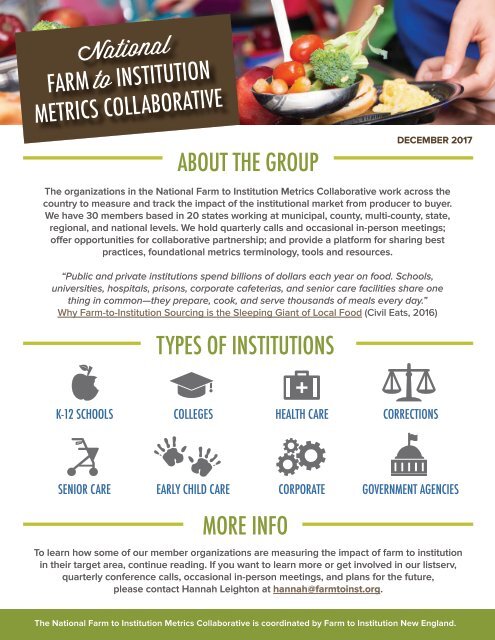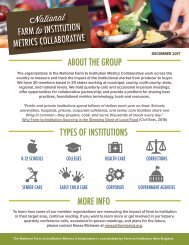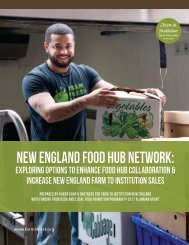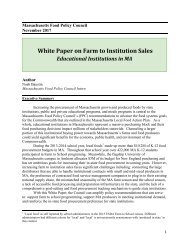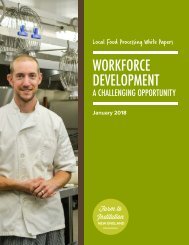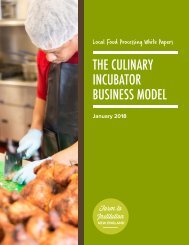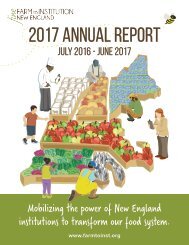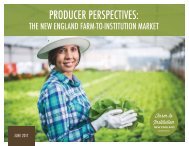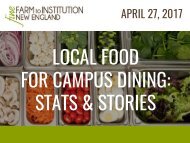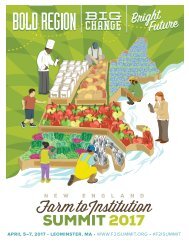Ntnl FTI Metrics Flyer
You also want an ePaper? Increase the reach of your titles
YUMPU automatically turns print PDFs into web optimized ePapers that Google loves.
National<br />
FARM to INSTITUTION<br />
METRICS COLLABORATIVE<br />
ABOUT THE GROUP<br />
DECEMBER 2017<br />
The organizations in the National Farm to Institution <strong>Metrics</strong> Collaborative work across the<br />
country to measure and track the impact of the institutional market from producer to buyer.<br />
We have 30 members based in 20 states working at municipal, county, multi-county, state,<br />
regional, and national levels. We hold quarterly calls and occasional in-person meetings;<br />
offer opportunities for collaborative partnership; and provide a platform for sharing best<br />
practices, foundational metrics terminology, tools and resources.<br />
“Public and private institutions spend billions of dollars each year on food. Schools,<br />
universities, hospitals, prisons, corporate cafeterias, and senior care facilities share one<br />
thing in common—they prepare, cook, and serve thousands of meals every day.”<br />
Why Farm-to-Institution Sourcing is the Sleeping Giant of Local Food (Civil Eats, 2016)<br />
TYPES OF INSTITUTIONS<br />
K-12 SCHOOLS COLLEGES HEALTH CARE CORRECTIONS<br />
SENIOR CARE EARLY CHILD CARE CORPORATE GOVERNMENT AGENCIES<br />
MORE INFO<br />
To learn how some of our member organizations are measuring the impact of farm to institution<br />
in their target area, continue reading. If you want to learn more or get involved in our listserv,<br />
quarterly conference calls, occasional in-person meetings, and plans for the future,<br />
please contact Hannah Leighton at hannah@farmtoinst.org.<br />
The National Farm to Institution <strong>Metrics</strong> Collaborative is coordinated by Farm to Institution New England.
COMMUNITY HEALTH IMPROVEMENT<br />
PARTNERS (CHIP)<br />
www.sdchip.org<br />
www.sdchip.org/initiatives/food-systems<br />
FEATURED MEMBERS<br />
Mission: To develop and lead collaborative solution<br />
making initiatives designed to overcome the significant<br />
challenges facing the health of our San Diego<br />
regional community. Of these, CHIP’s Food Systems<br />
initiative tackles obesity and nutrition-related illnesses<br />
by enabling a marketplace connecting healthy,<br />
sustainably-sourced, local farm foods to the community.<br />
<strong>Metrics</strong> Project Summary: CHIP Food Systems<br />
initiative connects farm to institution in order to improve<br />
the local farm economy and maximize benefit to the<br />
community by providing greater access to healthy<br />
foods. To support this work, CHIP has led various<br />
research projects, including its series on The State of<br />
Farm to School in San Diego County, as a means to<br />
show regional progress within the field. Due to CHIP’s<br />
extensive farm to school work, namely through our<br />
San Diego County Farm to School Taskforce, we have<br />
created a Farm to School Index metric to evaluate<br />
school district farm to school activity. In working with<br />
a broad (and growing) range of institutions, CHIP<br />
Food Systems is designing methods for collecting<br />
and analyzing farm to institution data. The need for<br />
developing shared metrics on a national level for this<br />
broad-level farm to institution evaluation is critical, and<br />
we believe the National Farm to Institution <strong>Metrics</strong><br />
Collaborative is a large step toward further progress.<br />
CULTIVATE MICHIGAN<br />
www.cultivatemichigan.org<br />
Mission: To work toward the Michigan Good Food<br />
Charter goal that Michigan institutions source 20% of<br />
their food from Michigan suppliers by the year 2020.<br />
<strong>Metrics</strong> Project Summary: Cultivate Michigan, the<br />
local food purchasing campaign of the Michigan<br />
Farm to Institution Network, is designed to help farm<br />
to institution programs grow and track progress. By<br />
joining Cultivate Michigan, institutions pledge to reach<br />
the 20% local by 2020 goal. Each year, we feature four<br />
seasonal foods and provide toolkits for each in order<br />
to make it easy for institutions to find, buy, and use<br />
local food. By highlighting these products, we hope to<br />
increase demand for them and improve access to them.<br />
Institutions track their local food purchases of featured<br />
and other Michigan foods. Together, we can watch the<br />
statewide impacts on the economy grow.<br />
ECOTRUST<br />
www.ecotrust.org<br />
www.food-hub.org/nwfba<br />
Mission: To inspire fresh thinking that creates economic<br />
opportunity, social equity, and environmental wellbeing.<br />
For 25 years, we have acted as a catalyst for radical<br />
and practical change in the Pacific Northwest, fostering<br />
resilience from the ground up. Our Food & Farms<br />
team works to build a robust regional food system that<br />
improves access by vulnerable populations to nutrientdense,<br />
regionally grown and processed food, while<br />
improving local economies and creating jobs.<br />
<strong>Metrics</strong> Project Summary: Ecotrust helped launch<br />
an association of schools, hospitals, assisted living<br />
facilities, and other large scale food buyers called<br />
the NW Food Buyers’ Alliance. This peer-to-peer<br />
network brings together more than 80 foodservice<br />
directors, who collectively make millions of dollars<br />
of food purchasing decisions each year in Oregon<br />
and Washington. Participants share best practices,<br />
visit farms, ranches, and each other’s kitchens, and<br />
compare notes on local purveyors. From 2014-2016,<br />
the Alliance saw a 114% increase in local purchasing<br />
by member institutions. Current areas of focus include<br />
harnessing the purchasing power of the alliance<br />
to transform regional supply chains, establishing<br />
common procurement goals, and building out a farm<br />
to institution metrics platform (in alignment with the<br />
national metrics collaborative).
FARM TO INSTITUTION<br />
NEW YORK STATE (FINYS)<br />
http://finys.org<br />
Mission: Spearheaded by American Farmland<br />
Trust, Farm to Institution New York State (FINYS) is a<br />
statewide partnership of agricultural, public health, and<br />
economic development organizations who have come<br />
together to provide new market opportunities for local<br />
farmers, while bringing healthy, high-quality food to<br />
people eating in schools, colleges, hospitals, senior<br />
centers, residential institutions and group homes. Our<br />
mission is to strengthen the economic security of<br />
farmers and the health of New Yorkers by empowering<br />
institutions to spend at least 25% of their food budget<br />
on food grown in New York.<br />
FARM TO INSTITUTION NEW ENGLAND<br />
www.farmtoinstitution.org<br />
dashboard.farmtoinstitution.org<br />
Mission: To mobilize the power of New England<br />
institutions to transform our food system.<br />
<strong>Metrics</strong> Project Summary: The New England Farm<br />
to Institution <strong>Metrics</strong> Project was initiated by Farm to<br />
Institution New England (FINE) in March 2015 to inform<br />
New England farm to institution stakeholders (e.g.,<br />
practitioners, policy makers, funders and financers,<br />
researchers) about the role of the farm to institution<br />
sector in our regional food system. It is a data-driven<br />
overview of the impact of the farm to institution supply<br />
chain, from production through consumption. The<br />
project focuses on three institutional sectors: K-12<br />
schools, institutions of higher education, and hospitals.<br />
We communicate key findings through an online<br />
dashboard (www.dashboard.farmtoinstitution.org),<br />
a set of six state profiles, a series of three original<br />
survey research reports and recorded webinars, a blog<br />
series, and more. We also make regular presentations<br />
to state, regional, and national policy makers and<br />
target audiences. Project data comes from national<br />
sources like the USDA’s Farm to School Census and<br />
the U.S. Census of Agriculture as well as regional data<br />
collected by our partners including Health Care Without<br />
Harm. FINE’s <strong>Metrics</strong> Project has also implemented<br />
three original surveys designed to fill gaps in existing<br />
baseline information on the farm to institution sector in<br />
New England for the following groups: food distributors.<br />
Institutions of higher education, and farmers.<br />
<strong>Metrics</strong> Project Summary: FINYS partners believe that<br />
transforming the local food economy requires systemic<br />
change and the efforts of many – from agriculture, public<br />
health, economic development, environment, education<br />
and other sectors. <strong>Metrics</strong> work is currently focused<br />
on collecting and publishing baseline data on food<br />
purchasing by publicly-funded programs in New York<br />
State. American Farmland Trust and FINYS partner New<br />
York Academy of Medicine have compiled information on<br />
these programs, the number of people served and the<br />
dollar value of food purchased for meals and snacks in<br />
K-12 schools, child and adult care, emergency food, and<br />
many other settings. The first Public Plate brief combines<br />
the baseline data with an analysis of the potential<br />
economic and public health impacts if 25% of those<br />
food budgets purchased fresh, minimally-processed<br />
foods grown or raised on farms in New York. Future<br />
briefs will focus on the impact of local food procurement<br />
within specific sectors including K-12 schools, healthcare<br />
and higher education to highlight the challenges and<br />
opportunities unique to these settings.<br />
From 2013-2016, FINYS coordinated a Farm to SUNY<br />
pilot with four campuses of the State University of New<br />
York (SUNY). Baseline data and increases in purchasing<br />
of New York-grown fruits and vegetables was tracked to<br />
measure the impact of technical assistance with sourcing<br />
and student-led promotions. Building on the success<br />
of that pilot, FINYS is conducting a survey of 55 SUNY<br />
colleges to collect information on food budgets and<br />
local food procurement practices, and to gauge interest<br />
in the goal of spending 25% of their food budgets on<br />
foods grown or raised on New York farms.
Photo Credit: USDA<br />
HEALTH CARE WITHOUT HARM<br />
www.healthyfoodinhealthcare.org<br />
Mission: To transform the health sector worldwide,<br />
without compromising patient safety or care, so that<br />
it becomes ecologically sustainable and a leading<br />
advocate for environmental health and justice. Health<br />
Care Without Harm’s national Healthy Food in Health<br />
Care program harnesses the purchasing power and<br />
expertise of the health care sector to advance the<br />
development of a sustainable food system.<br />
<strong>Metrics</strong> Project Summary: To date, HCWH metrics have<br />
focused on traditional process indicators with a focus<br />
on local and sustainable foods as well as meats raised<br />
without the routine use of non-therapeutic antibiotics.<br />
This information has been collected through a national<br />
survey, implemented every other year. In addition to<br />
data collection with the health care sector, HCWH works<br />
with cross-sector partners at the regional and national<br />
levels to align our metrics with those being used in the<br />
college and K-12 sectors. To this end, the New England<br />
HFHC Team is a member of the FINE metrics advisory<br />
board. At the national level, we are working with Real<br />
Food Challenge and School Food Focus to align metrics.<br />
In 2016, we started developing a national strategy to<br />
consistently and reliably capture procurement data from<br />
the health care sector. We are doing so in coordination<br />
with our sister organization Practice Green Health. We<br />
also aim to develop impact indicators and a strategy for<br />
data collection in order to help demonstrate the impact<br />
of these shifting procurement patterns. What does it<br />
mean for farmer viability? For ecological health?<br />
For public health?<br />
JOHNS HOPKINS CENTER FOR A<br />
LIVABLE FUTURE<br />
http://mdfoodsystemmap.org<br />
www.jhsph.edu/research/centers-and-institutes/<br />
johns-hopkins-center-for-a-livable-future/index.html<br />
Mission: The Maryland Food System Map Project is<br />
a project of the Johns Hopkins Center for a Livable<br />
Future. The project provides space for users to look at<br />
different parts of the food system geographically and<br />
offers resources to help discover opportunities and<br />
inform activities aimed at strengthening the system. The<br />
project strives to unite food systems data from disparate<br />
sources; to develop and grow the body of food systems<br />
data in Maryland; and to support our partners in their<br />
work to create an equitable, environmentally sustainable<br />
and economically viable food system in Maryland.<br />
<strong>Metrics</strong> Project Summary: Institutions play an important<br />
role in the food system as large purchasers and servers<br />
of food to Maryland residents. In 2014, the project<br />
developed and disseminated surveys to universities and<br />
hospitals in Maryland to collect data on the economic<br />
impact of purchasing local foods by major institutions.<br />
We created two-page briefs describing the results and<br />
made datasets available to our users. In 2016, we are<br />
continuing this data collection and — since they are<br />
key players in the institutional food chain — we are<br />
adding food distributors to the mix. By collecting and<br />
growing the data available on Maryland institutional<br />
food purchasing, both overall and locally sourced foods,<br />
the project will provide a rich dataset and case studies<br />
useful to our partners in planning and advocating for<br />
farm-to-institution policy and growth.
MISSOURI FARM TO TABLE<br />
agriculture.mo.gov/abd/financial/farmtotable.php<br />
Mission: (1) Allow institutions to more easily incorporate<br />
locally grown agricultural products into their cafeteria<br />
offerings, salad bars, and vending machines;<br />
(2) Allow institutions to work with food service providers<br />
to ensure greater use of locally grown agricultural<br />
products by developing standardized contract<br />
language for food service contracts.<br />
<strong>Metrics</strong> Project Summary: The Missouri Farm to Table<br />
Task Force is a collaboration of agriculture, public<br />
health, elementary education, university extension,<br />
corrections, military and state commodity buyers. The<br />
task force was expanded by a Senate bill in 2016 that<br />
changed the focus in Missouri from Farm to School to<br />
Farm to Table. The program goal is for participating<br />
institutions to use 10% of their food budgets specifically<br />
on Missouri product purchasing.<br />
To date, the only metrics available for the project are<br />
derived from the USDA Farm to School Census. Over<br />
the next two years, the task force plans to evaluate<br />
the possibilities of network expansion, as well as<br />
understand how farm to table will be measured by the<br />
different institutions. Work has begun on a seasonal<br />
harvest campaign, relevant certification initiatives<br />
and an increased presence in an online<br />
procurement system.<br />
YOUR ORGANIZATION HERE!<br />
The National Farm to Institution <strong>Metrics</strong><br />
Collaborative is an open group that<br />
welcomes new members. If you’re<br />
interested in joining or learning more<br />
about us, contact Hannah Leighton from<br />
Farm to Institution New England at<br />
hannah@farmtoinst.org.<br />
Photo Credit: Franklin Pierce University
NATIONAL FARM TO INSTITUTION METRICS<br />
COLLABORATIVE MEMBERS<br />
States with participating organizations<br />
The National Farm to Institution <strong>Metrics</strong> Collaborative consists of 30+ members based in more than<br />
20 states working at municipal, county, multi-county, state, regional, and national levels. On this map,<br />
green states are those containing members of the group. New members are welcome from all states!<br />
DANE COUNTY ECONOMIC<br />
DEVELOPMENT COUNCIL<br />
COR FINDINGS


